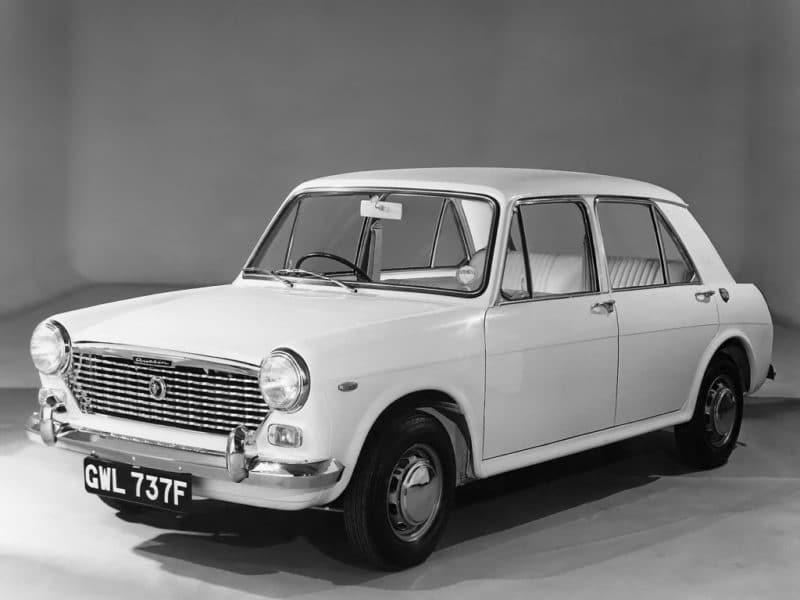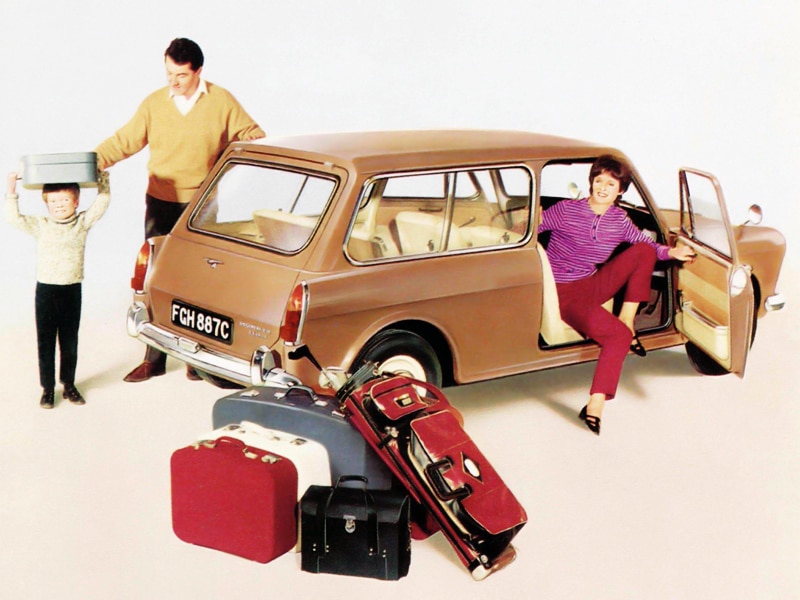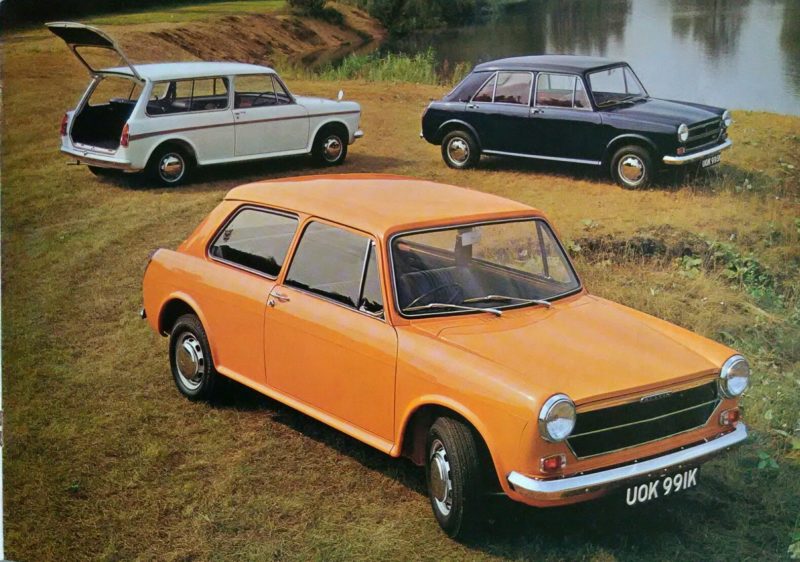The year 2022 is nearing its end. Many car models celebrated another special anniversary this year. As usual, we highlighted a number of these jubilees this year. Even now that the end of 2022 is in sight, we will not leave a historic car unmentioned. Or car: we prefer to speak of a series. Because BMC's ADO 16 series has been around for sixty years. There is so much to tell about this that we pay attention to this extremely sympathetic classic of British origin in three parts. Today the second part: the wide British range
The ADO 1962 made its debut in August 16 as the Morris 1100. Not much later the MG 1100 followed, which received a BMC A engine with a modified cylinder head and two carburettors. The multi-brand strategy had begun for the ADO 16 series. Demand for the Morris 1100 in particular was high. Waiting times of nine months were no exception on the home market, also because BMC considered the export markets important. For example, the production of CKD packages for New Zealand was in the pipeline. In addition, the strikes already played a significant role during the XNUMXs. The trade unions gained increasing influence and openly protested the difficult labor relations, pay structures and working conditions. Particularly in 'plant Cowley', the workers were very receptive, resulting in various work interruptions.
Gearing up, broadening ADO 16 range
In any case, BMC had to step up a gear. Night shifts were introduced for production, and a new, modern production facility was built in Longbridge. The new Austin 1100 was then produced there. That was the car that expanded the volume spectrum within the ADO 1963 series in 16. The Austin differed cosmetically from the Morris in details. BMC continued to do what it does best: take one base model as a starting point for several brands. The Morris and Austin were in the volume spectrum, the MG was one step above that, and so were the later number of available brands within the ADO 16. The Riley Kestrel and the Wolseley 1100 expanded the luxury end of the spectrum. The very luxurious Vanden Plas Princess was top of the line, with a corresponding price tag that you also get on a Volvo 122 S or a Citroën DS 19 found. The MG, Riley, Wolseley and Vanden Plas also got the 1098 cc engine with 2 SU carburettors. In the meantime, Innocenti (from 1963) in Italy and Authi in Spain (1966) built their versions of the ADO 16 series, you will read more about this in part 3 next week.
Estates and the 1275 cc engines
Developments also continued in Great Britain. In 1966 the Austin Countryman and the Morris Traveler appeared: three-door stations that were a nice addition to the range. In June of the turbulent year 1967 for BMC, the 1275 cc engine with 59 DIN hp appeared as an option for the MG, Riley, Vanden Plas and Wolseley versions. And in October of that year, BMC presented the ADO 16 Mk II models in London. The estate variants kept the design principles of Mk I. The Saloons were optically adjusted. The wings at the rear became more rounded, there were new interiors, indicators on the fenders and new grille types.
Austin and Morris 1300, sales drop due to production problems
The launch of the Mk II was also the moment to make the 1275 cc engine available for the Austin and Morris versions. All 1275 cc received a fully synchronized four-speed gearbox as standard, and an automatic transmission was also available (depending on type). The 1275 cc engine (known in basic form from the Mini Cooper S, among other things) was not an upgrade of the existing 1098 cc engine, but had a different engine block and a separate production line was required for that. This resulted in the necessary delay in the production of these engines, and therefore also in the delivery of the models.
Roerig 1967 puts pressure on the market position of ADO 16 models
In 1967, BMC greeted more problems. The supply of parts was also substandard, so it often happened that unfinished cars were waiting for completion. Chaotic logistics, poor working conditions and strikes cast an increasing shadow over the production of BMC models, the ADO 16 variants also suffered a lot. The result: within the home market of Great Britain, the Ford Cortina took over as the best-selling car. To transfer this back to….. the ADO 1968 models in 16.
Back at the top and the end of an illustrious name
The manual Riley, MG, Vanden Plas and Wolseley types received the stronger 1968 cc engine with two carburetors in 1275, the 1100 versions increasingly faded into the background for these badges. The Riley and the MG with 1300 engine were the most powerful with 71 DIN hp. This engine also came in the Austin and Morris 1300 GT, just like the gearbox with adjusted gear ratios used for the fast 1300 versions. When these two sporty types of the volume brands made their appearance, it was over and done with the Riley, which retired as 1300. In fact, the new British Leyland (1968) also put a painful line through the illustrious Riley brand name. And that had already been done with the four-door MG versions. In addition, the MG 1300 (two doors) was only available for the export markets.
MarkIII. The last ADO 16 chapter in Great Britain
Gradually, the ADO 16 range made a retreat. The British Morris ADO 16 models all disappeared from the scene in 1971, including the 1100. That was the ADO 16 debutant in 1962. The Marina took over on behalf of Morris. Nice detail: the name Marina had been used in Denmark for years for the Morris 1100. The third ADO 16 generation continued as far as Europe is concerned in 1974. The MG 1300 (the 1100 was already out of production), Austin Countryman and the Wolseley disappeared for a while. years earlier. In July of that year, all ADO 16 models still available in Europe were discontinued. The last ADO 16 built in Great Britain was…. a Vanden Plas Princess 1300. Shortly before that, British Leyland had pulled the plug on the Austin 1100 and 1300.
Long lasting concept, unmatchable by successors
This is how the career of the ADO 16 models came to an end in the home market, which was now plagued by serious social and economic problems. But despite the regular industrial and social headwinds, the ADO 16 series was successful. It was sold more than a million times on the domestic market. And rightly so, because in 1962 these cars were very progressive and modern. And with that, his designers ensured a long career. And fame, which made it almost impossible for his successors to step out of the beautiful shadow of the ADO 16 series. ADO 16 acted like a candle in the wind.
Next week you will read the final part of the series in part 3: Abroad and different, the foreign history (final)













It's a shame that so little of the British car industry has survived.
I, owner and driver of the French work, must admit that all brands such as Austin, Morris, Wolseley, Riley, MG etc are increasingly appealing to me.
Often still for sale for reasonable prices.
Is offered relatively less than the German and French work.
Thanks for these articles!
Nice cars, no better or worse than others, I've driven fiat, simca, renault. Also rust, also break. Golf 1, scirocco 1975, also rust problems due to only exterior paint and no rust prevention. It took the French 12 weeks to supply a starter motor for my Simca…I believe that the Minor, the Mini, the Glider and the Landcrab (big brother of the Glider) revolutionized their time, other self-supporting bodies, feed wheel drive, rationalization of components. England has lost its own market share on the one hand due to labor disputes and on the other hand due to poor management by not recognizing in time that customers can also buy a product elsewhere. Too bad, but I still find it fascinating, like to go to a fair or take the ferry to the other side. Brexit has made them even more difficult. Too bad, history repeats itself...
Beautiful cars. Childhood memories.
They never appealed to me. And I still find these English cars difficult to place. The first version is usually far ahead of its time and the latter have been greatly overtaken by time. In between, it's a grille, headlight or a badge that should make the difference.
My first car was a Morris 1100, then I had an MG 1300 MK II.
The MG in particular was quite fast, both cars had incredible handling, I lost everyone on winding roads.
I had a 1300 antelope beige MG1969 two-door, also had it treated with dinitrol, so that the price was indeed comparable to the Volvo Amazone and Citroën ID; later I had the part (under the chrome bagette sprayed in Jaguar chocolate brown). Beautiful, had a new gear installed in Dover in 1980, I had it until 1984 and sold it to a collector for 40.000 Bf (1000 euros) I still regret it.